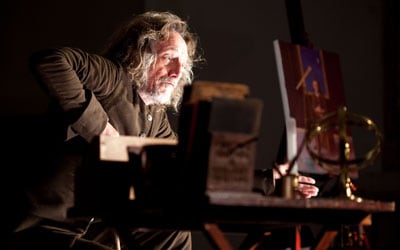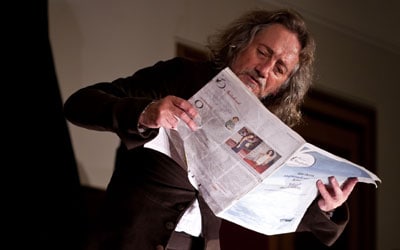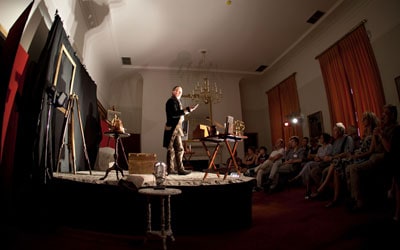Hanging Hooke
Dir. Siobhán Nicholas and Chris Barnes
The Royal Society, 2 October 2011
Shortly after lunchtime on Wednesday 26 June 1689, Robert Hooke began delivering one of his regular lectures at the Royal Society, London. These were dramatic performances in which he would entertain his philosophically minded peers with experiments, often using instruments he had developed himself. But in this lecture, Hooke digressed. “Many of those things I here first discovered could not find acceptance,” he protested. “Yet I find there are not wanting some who pride themselves in arrogating of them for their own.”
Quite how many developments in science and engineering should be credited to Hooke rather than to his contemporaries – especially Isaac Newton – had long been a matter of debate. Then, in 2006, a stash of mysterious papers turned up at a Hampshire country house that threw new light on the subject. They turned out to be Hooke’s long lost Folio – the minutes of meetings at the Royal Society during his tenure as curator of experiments. The Folio revealed that, as Hooke had always maintained, it was he and not the Dutch astronomer Christiaan Huygens who was the first to demonstrate a portable timepiece based on a balance spring. More importantly, it showed that Hooke was first to state that gravity causes the elliptical motion of the planets – an idea that Newton later honed into the famous inverse-square law.
These revelations have impelled the British playwright Siobhán Nicholas to create Hanging Hooke, which seeks to restore Hooke to his rightful place as one of history’s finest natural philosophers. It is an intimate, low-budget play, set on a makeshift stage and performed in monologues by a single actor, Chris Barnes, who switches between two different characters. One of the characters is John Hoskins, an amalgam of John Hoskins senior, one-time portrait painter of Charles I, and his son John “Jack” Hoskins, about whom much less in known. The other, naturally, is Hooke himself.
Hanging Hooke seeks to restore Hooke to his rightful place as one of history’s finest natural philosophers
We see Hoskins first, wracked with guilt in his studio as Hooke lies dying somewhere in London. Hoskins recollects how the young Hooke approached him as he painted on the Isle of Wight, even sitting down to copy his seaside paintings. They became good friends, so much so that Hoskins made him his assistant in London, where he learned of Hooke’s myriad ideas. “Had I discovered the English Leonardo?” he asks, using a now-common epithet. But Hoskins, a Royalist, had to travel to Saxony to escape the forces of Oliver Cromwell and, while there, he joined a secretive society, the Rosicrucians. In the play, this allies him with other Rosicrucians in the Royal Society, including Newton, and it is this allegiance that finally forces Hoskins to betray his friend – “My shameful task,” he says – by taking the Folio that proved Hooke’s prior claims to many innovations.
Despite his betrayal, Hoskins does a grand job of praising his friend’s lost achievements. So we learn that Hooke coined the term “cell” for biological organisms, after peering at pieces of cork through a microscope; that he was first to publish a wave theory of light; that he developed the first portable timepiece; that he built the vacuum pumps used by Robert Boyle in his gas-law experiments; that he designed telescopes that could reveal the rotation of planets; and that, like Leonardo, he had come up with dozens of blueprints for flying machines. In short, Hooke was a master polymath.
In the play’s second half, Hoskins transforms himself into Hooke – broad London accent, straggly hair, hunchback and all. Here, Barnes gives a commanding performance. At one point, we see Hooke give a lecture in which he uses one of his self-made pumps to demonstrate the effect of a vacuum on the human body. On stage, though, there is no pump – props are minimal – so Barnes creates the effect by standing on his head, describing the creeping asphyxiation that results. This is an impressive feat, and powerfully conveys the sacrifices Hooke made to advance knowledge.
Later, Barnes portrays Hooke as an aging hypochondriac, turned paranoid from overuse of quack remedies and bitterly resentful of his treatment within the Royal Society. In one scene, Hooke describes his most significant realization: that the planets move elliptically around the Sun, held in orbit by an attraction at a distance, namely gravity. He writes to Newton, explaining his revolutionary idea, but for years hears nothing in return. “What medicine do I take for this heavy, prescient spirit?” he asks. “What for melancholy?”
Hooke’s achievements should have made him a scientific superstar, yet somehow he faded into obscurity
Hooke had good reason to be distraught. His achievements should have made him a scientific superstar, yet somehow he faded into obscurity, becoming famous only for Hooke’s law – a rather boring relation that states that the extension of a spring is proportional to the force applied. Why didn’t he become a household name? Nicholas offers several explanations, one being Newton, who, we are told, ordered both the destruction of Hooke’s manuscripts and his portrait. (No surviving portraits of Hooke are known to exist.) Another is Hoskins, who embodies the failure of Hooke’s friends and family to preserve his legacy.
It was Newton, of course, who ultimately took credit for gravity. People can judge for themselves whether this was justified. Hooke had the initial idea, and may have suggested that the force between two objects followed an inverse-square law. But the play is one-sided, portraying Newton as a scheming, self-interested man who, as president of the Royal Society, could tweak history as he saw fit. This is a bit unfair. For all his brilliance, Hooke himself was wont to exaggerate his achievements, speculating about phenomena for which he had little empirical data – and it was almost certainly Newton who first thrashed out the mathematical details of gravitation.
Still, Hooke deserves his time in the limelight, and both Nicholas and Barnes have done a tremendous job of balancing explanations of his discoveries with the politics of the time, ensuring that the production never seems clunky. Around the tercentenary of Hooke’s death in 2003, several biographers re-explored his life, offering a much kinder portrait than those given in the past. Together with the uncovered Folio and Hanging Hooke, they have generated a resurgence of interest: a stone memorial now sits beside Christopher Wren’s Monument in London, which Hooke helped design, and a plaque has been placed in the crypt at St Paul’s Cathedral. Meagre offerings perhaps, but a good start in remembering the man about whom so much has been forgotten.






